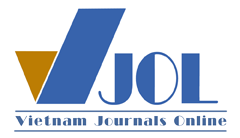Synthesis and Characterization of TiO2-Al2O3 Nanocomposite via Sol-gel Method
DOI:
https://doi.org/10.51316/jca.2021.091Keywords:
Nanocomposite, TiO2-Al2O3, thin film, transparent, hardness in Mohs scaleAbstract
TiO2-Al2O3 nanocomposite has been successfully synthesized by a sol-gel method and eight-layers films on quartz substrates were prepared by a spin coating technique. This work investigated the effect of the Ti4+/Al3+ ratio and annealed temperature on the Anatase and Rutile phase transition of TiO2 in TiO2-Al2O3 nanocomposite, transmittance of thin films in the visible region, and hardness of thin film. FESEM images show that the surface of the TiO2-Al2O3 nanocomposite thin film at the molar ratio of TiO2-Al2O3=7:3 is relatively homogeneous and crack-free with the thickness 190 nm. TiO2-Al2O3 nanocomposite thin films are highly transmittance (until 90%) in the visible light shown by UV-vis spectra. XRD patterns of TiO2-Al2O3 nanocomposite patterns are annealed in the air at temperature from 85 to 900 oC revealed that, the anatase phase of TiO2 is formed at temperature of about 700 oC, when temperature increase to 900 oC, the anatase phase changes to rutile phase.
Downloads
References
L. Reyes, G. Manuel, G. Lizangela, B. R. Barbara, C. Roberto, J. Adv. Mater. Process 6 (2018) 1–15
S. Y. Seung, K. B Yeon, Cho. N. Ihn, L. D. Yong, J. of Nanosci. and Nanotechnol. 15 (2017) 5228–5231. https://doi.org/10.1166/jnn.2015.10380
T. A. Otitoju, A. L. Ahmad, and B. S. Ooi, J. Ind. Eng. Chem. 47 (2017) 19–40, https://doi.org/10.1016/j.jiec.2016.12.016
J. Godnjavec, J. Zabret, B. Znoj, S. Skale, N. Veronovski, P. Venturini, Prog. Org. Coatings 77 (2014) 47–52. https://doi.org/10.1016/j.porgcoat.2013.08.001
E. Medvedovski, Wear 249(9) (2001) 821-828. https://10.1016/s0043-1648(01)00820-1
W. Zhang, R. Li, H. He, International J. of Photoenergy (2012) 1–7. https://doi.org/10.1155/2012/108175
A. F. Lotus. Mater. Sci. Eng. B Solid-State, Mater. Adv. Technol 167 (2010) 55. https://doi.org/10.1016/j.mseb.2010.01.027
A. Duta, M. Visa, S. A. Manolache, M. Nanu, 2008 11th International Conference on Optimization of Electrical and Electronic Equipment (2008) 461–466.
O. Frank, M. Zukalova, B. Laskova, J. Kürti, I. Koltai, L. Kavan, Phys. Chem. Chem. Phys. 14(42) (2012) 14567. https://doi.org/10.1039/C2CP42763J
J. Strunk, W. C. Vining, A. T. Bell, J. Phys. Chem. C 114 (2010) 16937. https://doi.org/10.1021/jp100104d
A. Akkaya, U. O., F. Z, Tepehan, Composites Part B: Engineering 58 (2014) 147–151. https://doi.org/10.1016/j.compositesb.2013.10.023
S. H. Mousavi, M. H. Jilavi, M. Koch, E. Arzt, P. W. Oliveira, Adv. Eng. Mater 19 (2017) 1-7. https://doi.org/10.1002/adem.201600617
S. A. Oliaee, S. Naghibi, Int J. of Appl. Ceram. Technol. 15(3), (2018) 689–700. https://doi.org/10.1111/ijac.12849
M.R. Mohammadi, Mater Sci in Semicond. Process., 2 (2014) 711-718. https://doi.org/10.1016/j.mssp.2014.07.051.
V. Dias, H. Maciel, M. Fraga, A. Lobo, R. Pessoa, F. Marciano, Materials 12(4) (2019) 682. https://doi.org/10.3390/ma12040682
M. P. Gonullu, H. Ates, Superlattices and Microstructures 142 (2020) 106529. https://doi.org/10.1016/j.spmi.2020.106529
M. M. K. Rahman, M. Akter, M. K. Amin, M. Younus N. Chakraborty, J. of Polym and the Environ/26(8) (2018) 3371–3381. https://doi.org/10.1016/j.spmi.2020.106529











